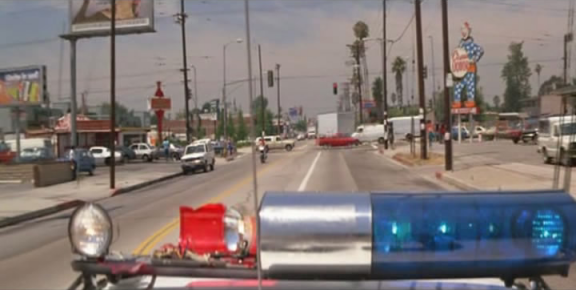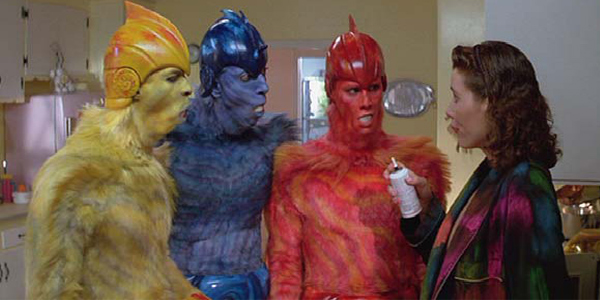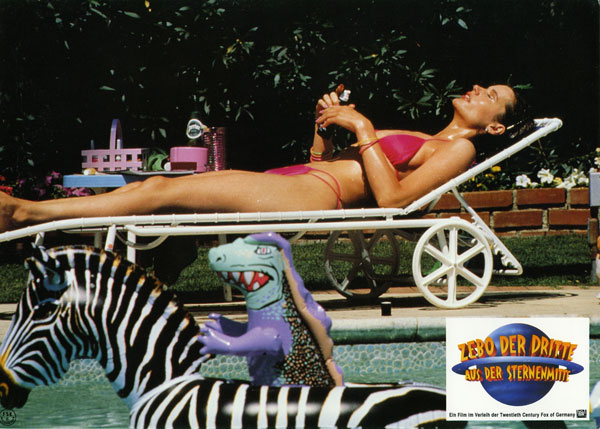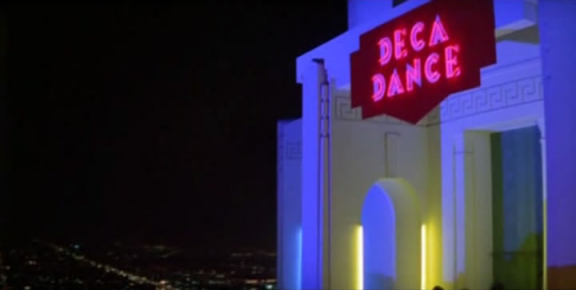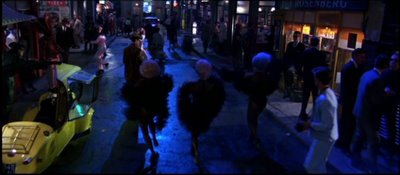From the Chicago Reader (May 12, 1989). — J.R.
EARTH GIRLS ARE EASY
*** (A must-see)
Directed by Julien Temple
Written by Julie Brown, Charlie Coffey, and Terrence E. McNally
With Geena Davis, Jeff Goldblum, Jim Carrey, Damon Wayans, Julie Brown, Michael McKean, and Charles Rocket.
One would like to think that this delicious new pop musical will finally give the talented English director Julien Temple the reputation and the commercial cachet that he deserves. Mainly known as a director of music videos for such groups as the Rolling Stones, Iggy Pop, Boy George, Billy Idol, and Janet Jackson, Temple has also pursued a fascinating fringe career in movies throughout the 80s, starting with his celebrated film with the Sex Pistols in 1980 (The Great Rock and Roll Swindle), and culminating with his brilliant Absolute Beginners in 1985. Along the way there have also been The Secret Policeman’s Other Ball, Mantrap, Running Out of Luck, It’s All True (a 1983 TV feature), and his virtuoso Rigoletto sequence in Aria, filmed in the kitschy splendor of California’s Madonna Inn.
On the basis of what I’ve seen, Temple is pretty much at the mercy of his material — although it’s worth noting that he appears to always or almost always work with the same gifted cinematographer, Oliver Stapleton. Working as court director and cowriter for Mick Jagger on the relatively feeble Running Out of Luck, with Jagger as star, executive producer, and coscreenwriter, Temple doesn’t function as much more than a competent craftsman. (The musical, filmed in Brazil, vaguely qualifies as Jagger’s version of Sullivan’s Travels — a series of contrived misadventures, glued together by various music videos, through which Jagger finds himself working with Brazilians on a sugar plantation.) On the hour-long It’s All True: A Cautionary Tale for the Video Age — a sort of free-form pop essay about TV and video that Temple wrote and directed — the room for imaginative directorial invention is a bit wider, and Temple takes good advantage of it. And when he winds up with still better material — as he does with Absolute Beginners, the Aria segment, and Earth Girls Are Easy — he comes across as a man with his own vision, the natural successor to the late Frank Tashlin, perhaps the most neglected of all the major Hollywood directors of the 50s.
Tashlin, the satiric poet of plastic and Day-Glo colors, was responsible for some of the best Jerry Lewis pictures and at least three other major comedies (Son of Paleface, The Girl Can’t Help It, and Will Success Spoil Rock Hunter?), all of which have yet to receive their due in this country. Although Tashlin’s filmography has its share of undistinguished entries, these and a few others are (along with the original Mad and the major works of Spike Jones and Tex Avery) the most exhilarating and formally inventive satiric celebrations that we have of American vulgarity in the 50s, as well as some of the most enduring modernist texts to be found in pop culture. (Tashlin’s early film work was in cartoons, and the proximity of these figures to the world of cartoons is far from coincidental.)
The fact that Tashlin’s movies tend to delight in what they satirize (and vice versa) has confounded many critics in this country. Andrew Sarris, for one, has argued that “one can approve vulgarity in theory as a comment on vulgarity, but in practice all vulgarity is inseparable.” Yet a mere look at Vladimir Nabokov’s Lolita — bolstered by Nabokov’s remark that “Nothing is more exhilarating than philistine vulgarity” — is all that one needs to refute Sarris’s notion. No less relevant is the major comic and formal influence of Tashlin on the films of Jean-Luc Godard, which can be discerned all the way from Godard’s earliest features to his most recent ones — an influence in which a love-hatred for American vulgarity clearly plays a major part. (For whatever it’s worth, it was reportedly a screening of Godard’s Contempt that convinced Temple to abandon his studies in history and architecture at Cambridge and enroll in film school.)
Among the more Tashlinesque aspects of Earth Girls Are Easy are a flurry of affectionate references to 50s icons, the use of a ‘Scope format and heavily saturated colors (which directly emulate the brilliant colors in the yellow range offered by Technicolor), a satiric use of brand names (a beauty parlor known as Curl Up & Dye, a “cuticle convention” called Nail Expo), and an unforced appreciation of the silly excesses of current technology, glamour, and pop culture. Where Temple differs most strikingly from both Tashlin in the 50s and Godard in the 60s is in his postmodernism — a distinctly different cultural attitude.
Consider first the bare bones of the plot: A manicurist in the San Fernando Valley named Valerie (Geena Davis) is afraid her fiance, a doctor named Ted (Charles Rocket), is losing interest in her. Her beautician boss, Candy Pink (coscreenwriter Julie Brown), persuades her to completely remodel her look (with the aid of an image processor), but it turns out that Ted has been two-timing her, so she throws him out of the house. Val sinks into despair, but is suddenly distracted by a spaceship that crashes into her swimming pool. Inside are three furry and horny aliens, named Mac, Wiploc, and Zeebo. From then on, the movie explores a series of transplanetary cultural exchanges between the aliens and Valley people. The difference between the two is minimized when Valerie’s boss Candy shaves off the aliens’ brightly colored fur to reveal humanlike hunks underneath. Blue Mac emerges as the handsome Jeff Goldblum, red Wiploc becomes a blond surfer type (Jim Carrey), and yellow Zeebo becomes a funky black dancer (Damon Wayans).
One easy way of distinguishing modernism from postmodernism is to note the different attitudes each takes toward the division between highbrow and popular art. While modernist artists ranging from Joyce and Eliot to Stravinsky and Eisenstein occasionally borrowed material from popular art to fit into their intellectual designs, they never went so far as to equate intellectual and popular elements. Even Frank Tashlin, who worked exclusively in popular forms — smuggling in simplified modernist tactics whenever he could — was never completely able to relinquish a certain irony and pathos toward some of his pop elements even as he celebrated them (most notably, Jayne Mansfield in The Girl Can’t Help It and Will Success Spoil Rock Hunter?).
By contrast, postmodernist artists as disparate as Thomas Pynchon, the Beatles, Philip Glass, and the makers of music videos (Temple included) think nothing of making Cuisinart blends without any sense of pathos or regret. The negative side of this can be seen in the average rock video, where the entire history of cinema — modernist and nonmodernist alike — is represented, but with all of its meaning and effect stripped away. Through a process of equalizing and synthesizing all sorts of contradictory materials, what tends to emerge is a kind of nerveless mush, easy to consume and often impossible to remember. But the positive side of this kind of mix, which the work of Temple illustrates, is the elimination of all the snobbery and condescension about culture and class that modernism often entails–and the implication, more pragmatic than pathetic, that if we have to eat mush, it might as well be tasty.
This is more or less where the virtues of Earth Girls Are Easy come in. While the satire in Tashlin’s movies was usually mediated to some extent by conscience-stricken, world-weary, or at least relatively “sophisticated” individuals who could make acerbic wisecracks about the absurdity surrounding them, there is no such figure within a million miles of Temple’s turf. All the characters, without exception, are unmitigated dumbbells, including the three aliens; and with the sole exception of Valerie’s cheating boyfriend Ted — a dumbbell who is also earmarked as a George Bush supporter — there are no villains in sight. Even more significant, all of the characters, including Ted, are regarded with a certain amount of delight and affection.
The dumbness of the characters exists on many levels at once. When the aliens see voluptuous skiers on a TV ad for Finland, one of them asks, “Is Finland here?” and Valerie replies, “This is the Valley. Finland is the capital of Norway.” Candy Pink, on the other hand, is a mistress of the mixed metaphor, as in “Have a mental margarita” or, more philosophically, “Men — give ’em enough rope and they’ll dig their own graves.”
If dumbness is evident in all the movie’s Valley people, it is equally evident in the aliens. And it is no less apparent in the expedient developments of the plot, which requires the aliens to virtually master the English language within a matter of minutes, and which obliges Curl Up & Dye’s cosmetic technology to adapt their physiques to Valley standards in a comparable jiffy. (Earlier, the diminutive size of the aliens in relation to Valerie is quickly and, it would seem, permanently altered by an equivalent bit of extraterrestrial technology.)
The dumbness of the special effects is even more pronounced, because they figure in the first and last scenes of the movie: an opening view of outer space and the alien spaceship that makes them look every bit as tacky and toylike as southern California; and a closing shot in which the equivalence becomes literal. But the point of all this dumbness isn’t exactly to make the audience feel smart, and it certainly doesn’t make the audience feel superior. The point, rather, is to see southern California from a slightly alien vantage point — the viewpoint of an appreciative Englishman who is perhaps able to see a little better than we can how bizarre the commonplaces of that culture happen to be.
Joe Dante used a similar viewpoint in the last reel or two of his Explorers (1985) when he offered a mimicking extraterrestrial beastie in a flying saucer displaying the results of an extended diet of TV. There the results were nightmarish as well as funny, and the absence of any similar feeling of disquiet in Earth Girls Are Easy is part of what makes the movie so seamlessly postmodern. When the three aliens immerse themselves in American culture through some TV channel changing, Temple makes this the occasion for a celebration of Jerry Lewis, as Buddy Love in The Nutty Professor (although he alters the sound track, substituting some jazz piano for Lewis’s vocal rendition at a piano of “That Old Black Magic”), and of James Dean, in Rebel Without a Cause. Various details from these clips are later reprised by the aliens at appropriate moments, but the effect of replaying them isn’t so much to subvert them or make them seem strange as to show that “aliens” can appreciate our culture as well as we do — perhaps even better, if we consider the resistance that most American directors would feel toward honoring Lewis.

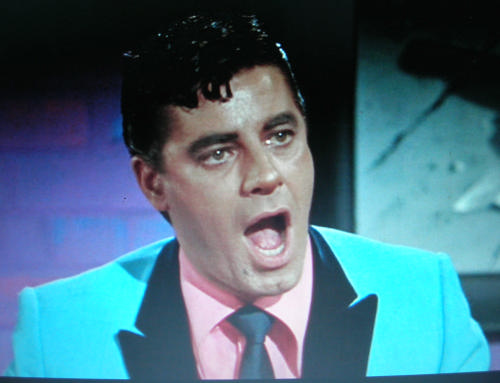
Temple’s references — like his nods to Jerry Lewis’s The Ladies’ Man and Busby Berkeley (among others) in Absolute Beginners — are those of a true connoisseur, without giving any sense of one-upmanship toward the audience. It’s probably no coincidence that when he chooses a western clip to include in the aliens’ TV survey, it’s a Raoul Walsh picture of the 50s (Gun Fury); similarly, he includes a bit from Cocteau’s Beauty and the Beast in a black-and-white dream sequence that mainly uses images from American science fiction movies.
The failure of Absolute Beginners to score with American teenagers was most likely due to the remoteness of its subject — London’s race riots of the 50s. That was a much more ambitious movie; but it might be argued that Earth Girls Are Easy, cheerful dumbness and all, is within its more carefully defined and modest limits a more successful one. It’s opening about half a year later than was originally intended, because the company that initially financed it, Dino De Laurentiis’s DEG, went bankrupt, but Ted’s “George Bush for President” bumper sticker is really the only detail that dates it. It’s probably asking too much, but with another genocidal Indiana Jones romp just around the corner, I’d love to see this tender piece of merchandise give the forthcoming Spielberg film a healthy run for its money.

